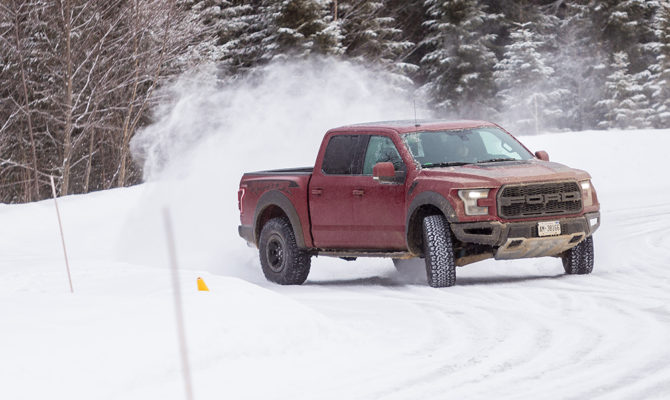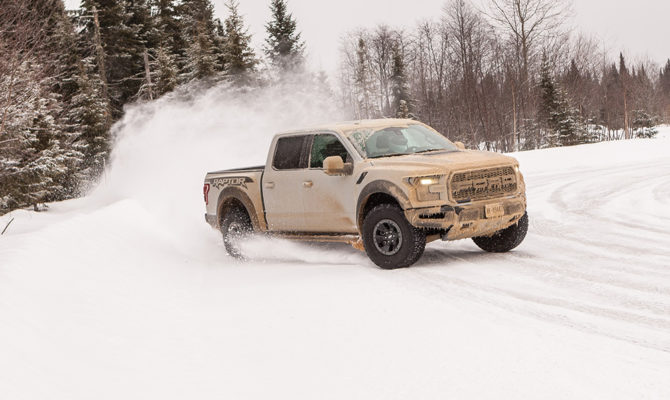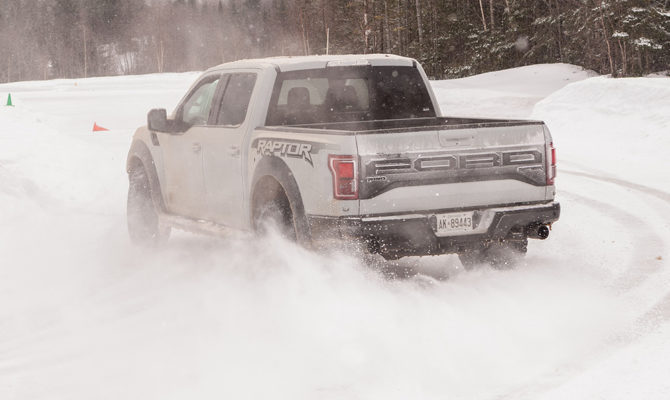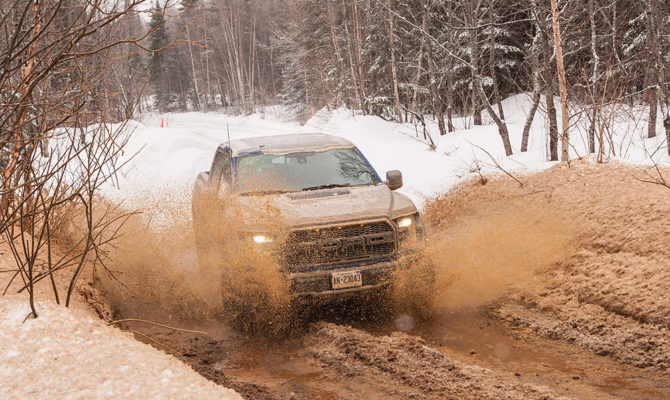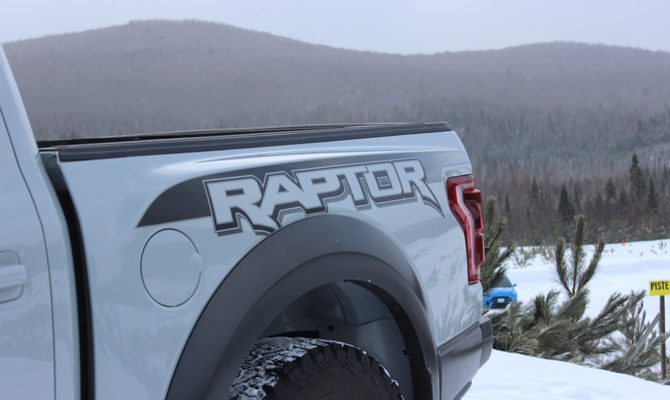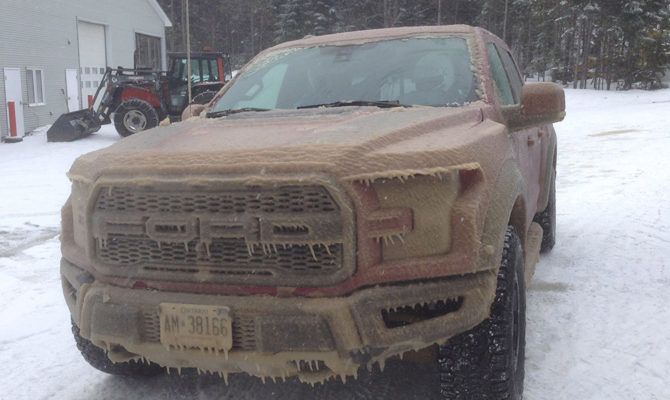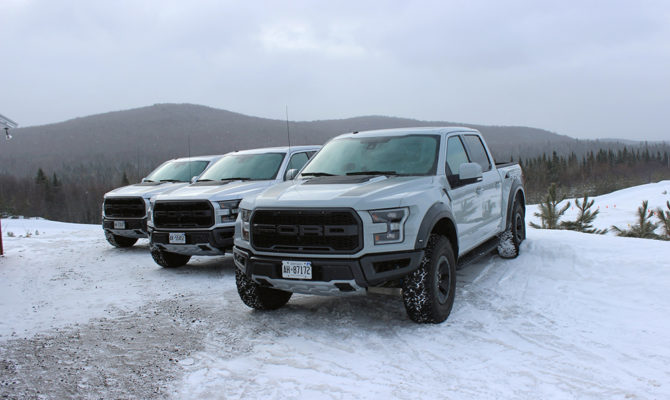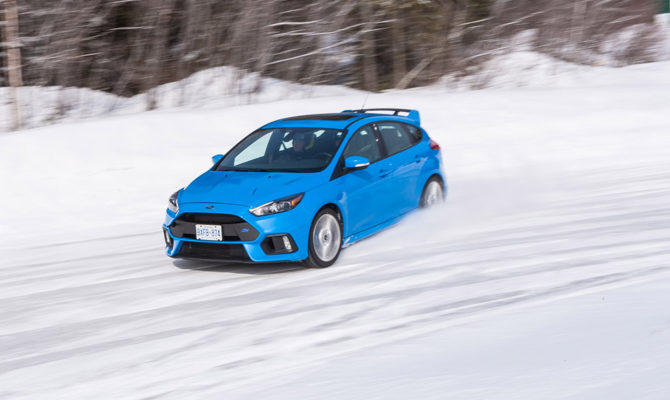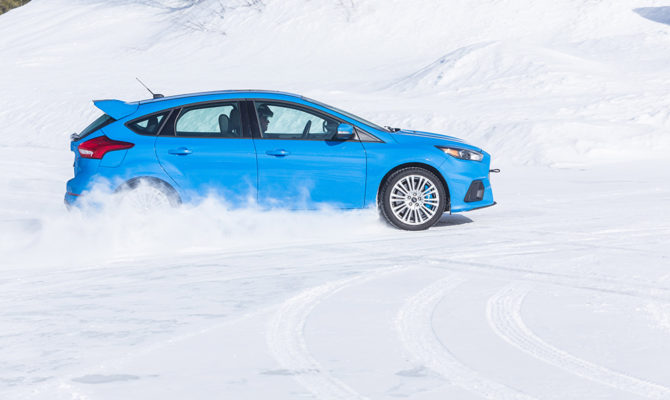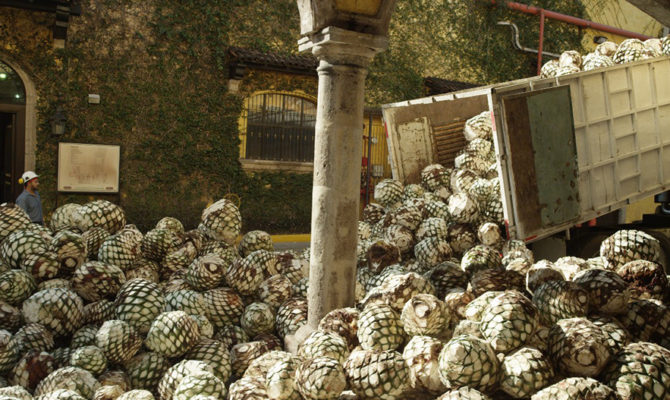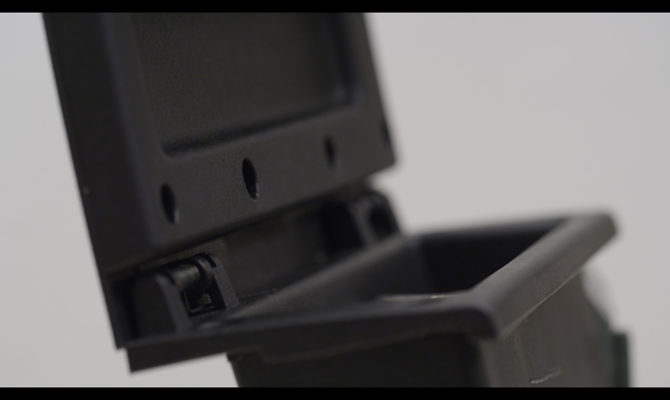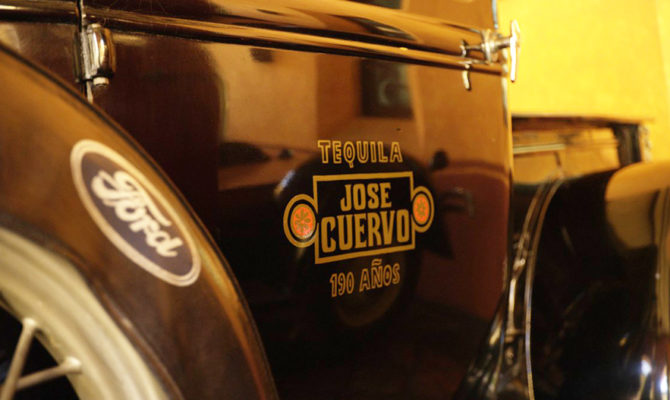(Montreal, QC) I am always down for a winter driving experience, let me tell you – and I don’t just mean what I get from everyday life out here in the Paris of the Prairies, Edmonton, either.
Ford Canada structured an event at the renowned Mecaglisse driving facility here in southern Quebec to show of the capabilities of two of the company’s everyday star performers; the 2017 Raptor and Focus RS
Both the Raptor and Focus RS are the progeny of Ford Performance and both are monsters in their respective class – not just on pavement (or in the Raptor’s intended hunting ground, desert) but wouldn’t you know it, both can handle themselves in Canadian winter.
We had a good day for it, too, though it wasn’t looking that way when I arrived in Montreal the day before the event. Like the rest of the country, Quebec has been getting highly variable weather, and where you could normally expect snow we got a day of rain that threatened to sour the winter driving fun; but luck (depending on your definition of ‘luck’) was with us, as the temperature dropped and new snow appeared overnight – covering a thick layer of ice.
The truck was my favourite, of course; the race-running, rally-ready pickup has always been a bundle of fun since its introduction; and the 2017 Raptor brings a new powerplant and transmission to its widened F150 platform.
A 3.5 litre EcoBoost V6 has replaced the eight-cylinder engine of previous generations, with an (also-new) 10-speed automatic transmission marshalling the 450 horsepower output.
Under the tutelage of professional instructors, sliding the lightened Raptor (the 2017 model has shed 227 kilos from the previous) around and ice-and-water course carved into the woods at Mecaglisse proved to be a great deal of fun; and a showcase for not only the power and handling of the vehicle, but the terrain-mode capabilities as well.
There are six programmed modes a driver can select from – as you might expect, the one called “weather” was demonstrated primarily in this exercise – and coupled with an ever-more robust suspension (the Raptor’s standard ‘Fox Shox’ have been enlarged and the length of travel elongated) and exclusive-to-Raptor BF Goodrich KO2 tires, it is up to any off-road challenge.
Which is not to say that a 2017 Raptor can’t mind its manners on regular roads. Take it to the pavement and it provides a ride as smooth (and a cabin as quiet) as, say, an F150 King Ranch; with a passenger environment every bit as well-appointed, I might add.
Now, while the Raptor is a lot of fun on snow and ice, it can’t match the sporty small-car agility of the Focus, especially when kitted out as the 2017 Focus RS (which Ford also brought a small fleet of to the track).
Running on studded tires for our demonstration, it held firm to the sheet of ice beneath our wheels. With a manual gearbox and standard-equip all-wheel drivetrain (which features a really clever torque-vectoring system, designed to modulate the spin of each wheel when you push the Focus RS hard (especially into the icy corners on the track), the car knows how to rock its exceptional power.
The RS is a more aerodynamic and purposefully-designed beast than the standard Focus (and it is also significantly more expensive, coming in at over 50K after taxes and destination fees), made for deep-pocketed buyers with a need for speed.
The centre piece is the 2.3L turbo four-cylinder engine under the hood – potentially 350 horses and a matching 350 lb.-ft. of torque on tap – bolstered with a couple of selectable drive modes; much like the Raptor but with different intent.
There is Track and Drift mode, the results of which are fairly self-explanatory, and the 2017 RS also gets a Launch Control function, for high power takeoffs from a standing start.
I won’t pretend that I mastered them all, of course, I’m not exactly a professional performance driver, but the best thing about situations like this event is that there are extremely talented driving instructors on hand to show wannabes like myself how it is truly done. Right about the time we of the press start to think that we’re getting the hang of handling the Focus RS on the ice, we switch seats and the instructors take us for a hot lap around the course to show us how professionals do it. Good fun indeed!
Frankly, a day of instruction and hands-on demonstrations at the Mecaglisse facility in Ford’s finest high performers is (almost) enough to make me wish winter would stick around a bit longer.
“The Canadian International Auto Show media preview featured 41 “New to Canada” vehicle premieres and for the first time ever a “World Premiere”, which was video cast globally, of the 2018 Hyundai Accent.”
Just weeks into 2017, Ford has introduced its all-new 2018 Expedition, loaded with tech.
“When Expedition was introduced 20 years ago, it set the standard for active families who simply needed a big and strong SUV to take them places,” said Joe Hinrichs, Ford president of The Americas. “Today’s families want even more smart technology to help them cover more ground safely, more efficiently and more comfortably – all while staying connected to friends and family.”
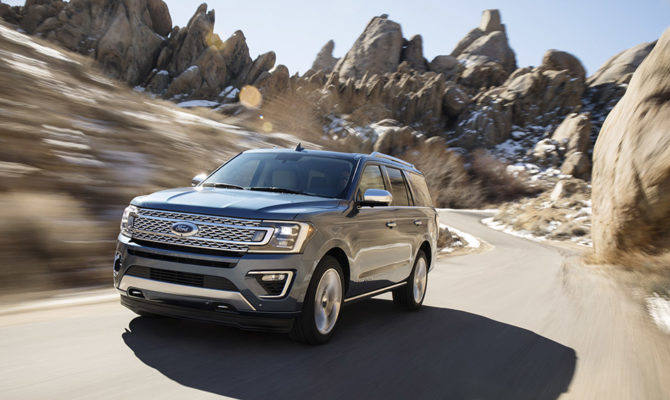
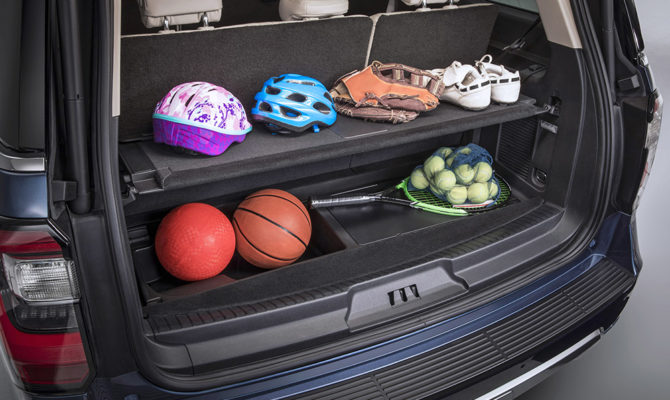
The all-new Expedition offers more driver-assist technology than any other full-size SUV with more than 40 features.
These include class-exclusive enhanced active park assist to easily pull in and out of parking spots, as well as available 360-degree camera technology to help customers see more around their vehicle for easier parking.
In addition, Expedition offers available new connectivity technologies and convenience features, including:
*Wireless charging; Expedition is Ford’s first vehicle to feature this system, which allows customers to place compatible mobile devices on an integrated charging pad conveniently located in the front center console
*Wi-Fi hotspot supports as many as 10 devices at once, up to 50 feet away from the vehicle
*Dual-headrest rear seat entertainment system provides a next-generation video experience that allows passengers to view their home cable programming on either of two video screens or hand-held devices
*SYNC® 3, with both Apple CarPlay™ and Android Auto™ capability, allows drivers to stay connected on the move
*SYNC Connect lets owners connect with the vehicle remotely using FordPass® to start, lock, unlock and locate their vehicle from anywhere, while also allowing access to important vehicle diagnostic information
*Power for passengers in every row, with four 12-volt power points, six USB chargers and a 110-volt power outlet that lets passengers stay charged and connected
*12-speaker B&O PLAY premium audio system perfected by acoustic engineers for a sound experience even audiophiles will appreciate
*Advanced cargo manager with an adjustable shelf behind the third row lets owners create a storage space customized to whatever they’re hauling; even when parked on a hill, cargo won’t roll out the back of Expedition when the liftgate is opened
Powered by a 3.5-liter EcoBoost® engine with standard Auto Start-Stop plus a class-exclusive new 10-speed automatic transmission, the all-new Expedition is the most powerful Expedition ever. A newly available electronic limited-slip differential on models with Intelligent 4WD enables improved off-road capability by sending power where it’s needed.
The Expedition seats up to eight people and their gear. It is the first full-size utility to feature a sliding second-row seat with tip-and-slide functionality, providing easy access to the third row without the need to first remove a child safety seat.
Expedition’s second- and third-row seats can be quickly folded flat with the push of a button to open up a cargo area wide enough to handle 4×8-foot sheets of plywood and other gear, depending on cargo weight and load distribution, even with the liftgate closed.
The all-new Expedition arrives this fall.
New cash incentives for purchase now make it possible to buy all-electric vehicles for a discount of up to $11,000.
This means the popular Nissan Leaf and Ford Focus Electric can be bought for a sticker price well under $30,000 for those prepared to scrap their old bangers.
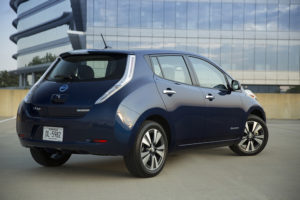
For the 2016 model year, LEAF adds a number of significant enhancements – beginning with a new 30 kWh battery for LEAF SV and LEAF SL models that delivers an EPA-estimated driving range of 107 miles* on a fully charged battery. The range of a LEAF S model is 84 miles, giving buyers a choice in affordability and range.
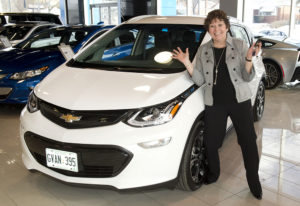
The game changer came when the BC SCRAP-IT Program announced it will offer an incentive of $6,000 for anybody who turns in their beater for scrap and purchases a qualifying new electric vehicle. That’s double the current incentive of $3,000, which now will be made available to buyers of used EVs.
This combines with the BC Government’s CEVfoBC program, which discounts EV purchases by $5,000.
“The goal of this incentive is to remove older high polluting vehicles from our roads in order to
lower exhaust pollutants across the province,” says Dennis Rogoza, BC SCRAP-IT Program CEO. “Ultimately, through programs like these, greenhouse gas emissions in our province will be dramatically reduced.”
SCRAP-IT’s voluntary early retirement vehicle program is designed to reduce greenhouse gas emissions and to reduce smog exhaust emissions across the province. All scrapped vehicles and their components are permanently and properly recycled. To date, the BC SCRAP-IT Program has removed more than 40,000 polluting vehicles across the province.
The technologically advanced new EVs offer huge fuel saving costs but few could be bought for less than $30,000 so it was hard for them to compete against miserly motors costing sometimes $10,000 or more less.
All three trim levels of the LEAF, which starts at $33,998 (before incentives), have an average range of 172 kilometres on a full charge. The Ford Focus Electric has the best price point at $31,998 and a range of around !20 km/h.
Last week, Chevrolet Canada began deliveries of the first Bolt EVs to Canadian customers. It has the heftier price tag of $42,795 but it’s EPA-estimated 383 kilometres of range on a full charge will tempt some to quit their expensive gas habit.
SCRAP-IT will also have a booth at the Vancouver International Auto Show,
March 28 – April 2 at the Vancouver Convention Centre. For more details about the BC SCRAP-IT program’s incentives and information, visit scrapit.ca.
Keith Morgan picks five trendy faves from Ford, Infinity, Lincoln, Hyundai and Chevy at the L.A. International auto show
Mark Fields, Ford Motor Company president and chief executive officer, believes we’re on the cusp of a mobility revolution.
The visionary leader painted a bright picture of our transportation future in his opening address to the 2016 AutoMobility LA conference, staged with the LA International Auto Show.
“We at Ford are excited about that because we’ve literally spent more than 100 years getting ready for this moment. We’ve always used world fairs as an opportunity to talk about how we envision the future.
“At the 1939 world’s fair, we had an exhibit there we called the “Road of Tomorrow,” he said. “It featured a service station and presented the idea that infrastructure upgrades would soon allow drivers to travel the entire country with ease. At the 1964 world’s fair, Ford created a seven-acre journey ‘into the fabulous future.'”
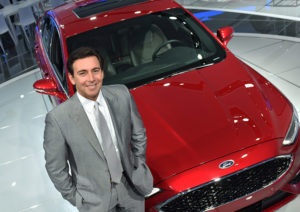
Detroit, January 12, 2016 — Mark Fields, President, Chief Executive Officer, Ford Motor Company, with the 2017 Ford Fusion at the North American International Auto Show.
Fields drew few laughs when he pointed out that 120 years ago, horses were the cutting edge of personal mobility.
He added: “Before mass production of affordable automobiles, most people never ventured more than10 miles (16 kms) from home. What’s interesting is that the time people spend moving from point A to point B has remained remarkably constant.
“People all over the world are moving, on average, an hour to an hour and a half every day, and that’s been true for several hundred years. What’s changed is the distances people are travelling.”
Today, Ford is not only dreaming about the Road of Tomorrow, but also focused on creating the City of Tomorrow. There are serious challenges, he warned and offered a different view of the congestion problem.
“Imagine if we focused on optimizing roads for the total number of people on them instead of the total number of vehicles. What if we could transform a commute from something painful into an opportunity to take a class, watch a movie or play a game? Or think about this: What would a city look like if more people were using shared services versus personally-owned vehicles?”
“At Ford, we’ve seen how exciting and liberating it is to imagine the future of mobility in this way.”
He explained that Ford responded by creating a City Solutions team to work with cities around the world to help map the future, starting with San Francisco and growing from there.
“We know every city is unique, with different needs and unique transportation challenges. Instead of offering a single set of solutions to all cities, we’re working with each city directly to identify the needs of its citizens and tailor transportation solutions for them.”
He cited the example of an app-based, crowd-sourced shuttle service called Chariot, which offers commuters a way to get to and from public transport locations. It’s operating in San Francisco, Austin and there are plans to roll it out in four more cities soon.
The company is also partnering with Motivate and Bay Area bike share to launch Ford GoBikes, providing yet another way for people to move easily around the city.
“Importantly, leading in these mobility solutions and working together with cities is good for our business. Ford has been a longtime partner to cities as a leading provider of vehicles for police, rescue and taxis in cities around the world. That will continue and even grow as we become closer to key cities, which will improve our core business of building great vehicles.”
I can’t think of a better looking Mustang; it draws on a rich design heritage.
Ford Motor Company is teaming up with Jose Cuervo to explore the use of the tequila producer’s agave plant byproduct to develop more sustainable bioplastics to employ in Ford vehicles.
Ford and Jose Cuervo are testing the bioplastic for use in vehicle interior and exterior components such as wiring harnesses, HVAC units and storage bins. Initial assessments suggest the material holds great promise due to its durability and aesthetic qualities. Success in developing a sustainable composite could reduce vehicle weight and lower energy consumption, while paring the use of petrochemicals and the impact of vehicle production on the environment.
“At Ford, we aim to reduce our impact on the environment,” said Debbie Mielewski, Ford senior technical leader, sustainability research department. “As a leader in the sustainability space, we are developing new technologies to efficiently employ discarded materials and fibres, while potentially reducing the use of petrochemicals and light-weighting our vehicles for desired fuel economy.”
The growth cycle of the agave plant is a minimum seven-year process. Once harvested, the heart of the plant is roasted, before grinding and extracting its juices for distillation. Jose Cuervo uses a portion of the remaining agave fibres as compost for its farms, and local artisans make crafts and agave paper from the remnants.
Now, as part of Jose Cuervo’s broader sustainability plan, the tequila maker is joining forces with the automaker to develop a new way to use its remnant fibres.
“Jose Cuervo is proud to be working with Ford to further develop our agave sustainability plan,” said Sonia Espinola, director of heritage for Cuervo Foundation and master tequilera. “As the world’s No. 1-selling tequila, we could never have imagined the hundreds of agave plants we were cultivating as a small family business would eventually multiply to millions. This collaboration brings two great companies together to develop innovative, earth-conscious materials.”
Jose Cuervo is family-owned and operated. Founded in 1795, it has been making tequila for more than 220 years with the same experience, craftsmanship and recipes that have been handed down generation through generation.
The collaboration with Jose Cuervo is the latest example of Ford’s approach to product and environmental stewardship with the use of biomaterials. It began researching the use of sustainable materials in its vehicles in 2000. Today, the automaker uses eight sustainable-based materials in its vehicles including soy foam, castor oil, wheat straw, kenaf fibre, cellulose, wood, coconut fibre and rice hulls.
According to the United Nations Environment Program, five billion metric tonnes of agricultural biomass waste is produced annually. A byproduct of agriculture, the supply of materials is abundant and often underutilized. Yet the materials can be relatively low cost, and can help manufacturers to offset the use of glass fibres and talc for more sustainable, lightweight products.
“There are about 400 pounds of plastic on a typical car,” said Mielewski. “Our job is to find the right place for a green composite like this to help our impact on the planet. It is work that I’m really proud of, and it could have broad impact across numerous industries.”
Ford continues its quest to bring us ground breaking new active safety technologies in affordable automobiles (more…)
Despite the ugly weather, the 2017 Ford Escape had much to distract yours truly in the way of technology and driveability.
(more…)
Recent Comments
- { Enjoyed your Forest of Bowland in the BMW X5M, particularly the photo of the BMW in front of the main part of Stonyhurst College where... }
- { Bantam designed the Jeep, not Willy's or Ford. The American military gave the original Bantam prototype to Willys and Ford to copy. There is plenty... }
- { All Escalades come with a 6.2-lilter V8 engine that produces 420 horsepower. A six-speed automatic is the only transmission offered and drives the rear wheels.... }
- { Alexandra is an excellent journalist. }
Popular Posts
- Journey to a ‘Sparkling’ Luxury Okanagan Resort “Four lucky readers will put a Dodge Journey’s weekend-...
- The Need For Speed: Hike Those Highway Limits More than half of those polled believe the province sho...
- Drives-U-Crazy… Erratic drivers. An early morning drive from Kelowna to Vancouver is nor...
- Readers Respond: The Pros and Cons of Increasing B.C. Speed Limits Increasing the speed limits will only increase risk to...
- Honda CR-V Review: The Compact Crossover To Get Things Done The CRV is a very stylish and aerodynamic crossover veh...


